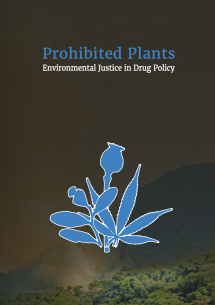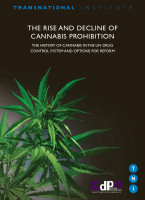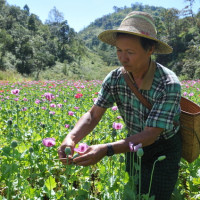Prohibited Plants Environmental Justice in Drug Policy
Regions
Across the world, the state of environmental stress is unprecedented. As scholarship and activism on ‘environmental justice’ points out, poorer and marginalised communities face particular exposure to environmental harms. This holds particularly true for populations in the global South. The role of illicit drugs in relation to these environmental stresses is an underexplored terrain. Yet, as this report will argue, drugs, as well as the policy responses to them, are an environmental issue.

Downloads
Authors
This disconnect between drug and environmental policy is the result largely of the institutional compartmentalisation of the issue of drugs into the domain of crime and law enforcement with little outreach to other spheres related to the environment or sustainable development. References to the environment within drug policy have as such remained sparse and limited in scope.
This is slowly changing. A resolution on alternative development adopted by the Commission on Narcotic Drugs (CND) - the central drug policy-making body within the UN system - in March 2022 gave special attention to environmental protection, encouraging “Member States to examine and address, within the efforts of alternative development, the harmful impact of the illicit cultivation of crops used for the production of narcotic drugs on the environment, which may lead to deforestation and the pollution of soil and water, and to seize the opportunities offered by alternative development with regard to the conservation and sustainable use of the environment and the protection of biodiversity”. And for the first time this year, the 2022 United Nations Office on Drugs and Crime (UNODC) World Drug Report includes a special booklet on the connection between illicit drugs and the environment.
This report, which draws on TNI’s original research, fieldwork, interviews and a broad literature review, aims to add to this burgeoning debate in the following ways:
- By examining the drugs-environment nexus in relation to trajectories of agrarian change and the implications for rural working people, especially in the global South. This is in recognition of the fact that what are currently deemed to be illicit crops under the international drug control regime often have a long history of traditional cultivation and use by rural communities and indigenous peoples across the world. In addition to long- standing traditional uses, many more rely on the cultivation of illicit crops for both their economic production and social reproduction activities. At the same time, these rural people are often most at risk of poverty, marginalisation, discrimination, and criminalisation while being least represented in policymaking spaces and in decisions that affect them. Elevating the voices and perspectives of these growers of illicit crops (or producers of prohibited plants) and the communities in which they are embedded is therefore a key aim of this report.
- By critically interrogating both drug policy and development responses in relation to the drugs-environment nexus. From toxic eradication campaigns that spray the ground with chemicals, to interdiction efforts which push illicit cultivation into ever more fragile ecosystems, drug control policy has been responsible, directly or indirectly, for a number of grievous environmental harms. Additionally, crop-substitution programmes which ignore the fact that for millions of peasants, small farmers, landless, and migrant labour populations, drug crops are the alternative development to trade and investment regimes from which they are either excluded or adversely incorporated into will ultimately fail.
- By bringing in scholarship and literature from, inter alia, the field of political ecology and critical agrarian studies and applying this to the issue of drugs and the environment, it is hoped that further exchange between these two hitherto quite separate spheres of enquiry can be stimulated. Drugs are an environmental issue. By making this case, it is hoped that policymakers, researchers, civil society organisations and social movements from both fields can be encouraged to engage in a process of mutual learning and knowledge exchange. Through this bridge-work, new forms of solidarity, scholar-activism, and policy change can coalesce around, for example, movements for climate justice, agroecology, or peasants’ and indigenous’ rights.
Key points and recommendations
- The impacts of so-called ‘Prohibited Plants’ or illicit drug crops – principally coca, opium poppy and cannabis – on the environment are an issue of concern. depending on the particular context, they have, to varying degrees, been associated with soil erosion, land degradation, desertification, water depletion, deforestation, biodiversity loss, and an increase in greenhouse gas emissions, pollution and waste
- Despite this, drugs are rarely seen as an environmental issue. There is no mention of drugs in any of the recent global climate or biodiversity agreements and within drug policy circles, environmental issues have, until very recently, only been debated at the margins. This disconnect stems from an institutional sequestering of drugs within the framework of crime and law enforcement
- Greater coordination between UNODC, UNDP, UNEP, as well as a prominent role for the Task Team supporting implementation of the UN common Position on drug policy, can help to foster Un system-wide coherence, support the implementation of the 2030 Sustainable development Agenda, and global commitments to dramatically reduce greenhouse gas emissions
- Greater synergies can be forged by assessing drug policy against a set of cross-cutting climate and environmental indicators, in addition to those developed around human rights, public health, sustainable development etc. There is much to be gained by bringing in relevant natural resource and human rights governance instruments such as the CFS guidelines on the Responsible governance of Tenure of land, Fisheries and Forests and the United Nations declaration on the Rights of Peasants and Other People working in Rural Areas
- The development of an environmentally sustainable drug policy must stem from an approach centred on environmental justice: the recognition that poorer and marginalised communities, often differentiated along class, gender and racial lines, face particular exposure to environmental harms. This holds especially true for populations in the global South
- In the field of drug policy, this means that those who depend on the cultivation of illicit crops for their economic survival and social reproduction must be at the heart of decision-making processes that affect them. It also means that rather than focusing on the persecution/criminalisation of people on the basis of particular uses of plants, the underlying political and economic systems of oppression, discrimination and injustice that ultimately drive environmental harm must be examined.
- Critically interrogating drug control policies can yield important environmental benefits. All forms of forced eradication – be it through aerial fumigation or manual means - must be ended. These have been shown to be environmentally destructive as well as ultimately counter-productive given evidence of the well-known ‘balloon effect’ whereby cultivation simply shifts to other, often more ecologically fragile, areas. meanwhile, the logic of interdiction can also be questioned from an environmental point of view given the number of hectares of land that are ‘wasted’ due to the destruction of seized product and the inevitable re-planting that follows on from this.
- Ultimately, the power of drug-trafficking organisations can best be challenged by taking away their source of profits that result from prohibition while strengthening forms of community resource access and control to help counter the influence of these non-state actors, with special protections in place for environmental and human rights defenders.
- In the realm of alternative development, there must be a clear red line drawn that replacing illicit crops with industrial monocultures or other big agro-commodity complexes should not be cast as AD programmes. Rather, AD programmes should actively seek to promote and strengthen sustainable production systems based on agroecology and regenerative practices combined with a comprehensive agrarian reform programme that supports territorial markets and more equitable access to and control over natural resources (land, water, seeds, forests etc.).
- While there are possible opportunities within Ad programmes to tap into sources of climate finance, there are also risks involved in market-based conservation mechanisms and natural capital accounting that further the commodification of nature at the expense of pro-poor outcomes. Public policy should reward models of agrarian environmental justice and community driven conservation strategies based on principles of co-creation between humans and nature.
- Ongoing drug policy reforms, particular in relation to cannabis, open up the possibility to develop forward thinking strategies for addressing questions around environmental sustainability. The high carbon footprint associated with indoor cultivation of cannabis means that, as much as possible, priority should be given to outdoor cultivation, particularly from traditional producing countries in the Global South.
- Environmental standard setting through e.g. organic certification (including peer-to-peer forms of certification), eco-labelling, appellation systems, and fair trade can and should all be considered to ensure environmental sustainability in regulated markets. Additionally, public agricultural research and seed banks should seek to conserve genetic diversity and local landraces.





